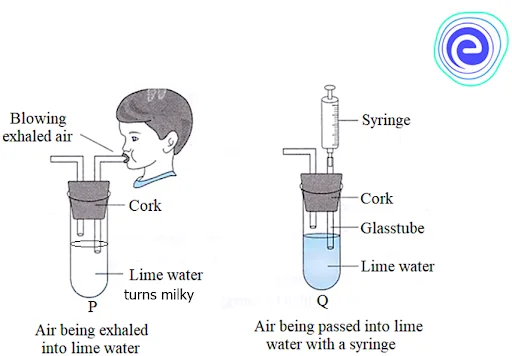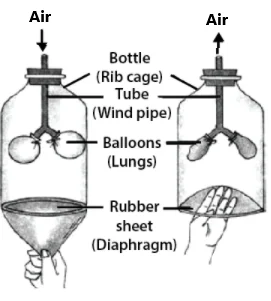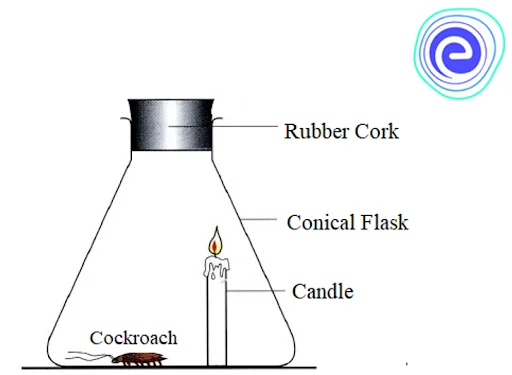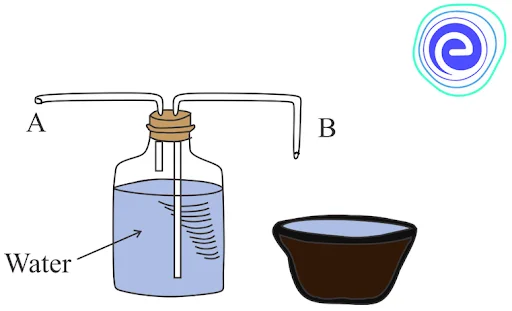- Written By
Priyanka Srivastava
- Last Modified 30-01-2025
Some Experiments on Breathing and Respiration: Meaning, Different Experiments
Some Experiments on Breathing and Respiration: Do you know that we lose water during exhalation? If yes, then can you prove it? During respiration, our diaphragm contracts and relaxes, which results in the expansion and deformation of our lungs. But can you show this experimentally? How can you prove that carbon dioxide is given out during exhalation? These experiments are discussed in this article.
It is important to know these experiments as we cannot see what is happening inside our body, but if we can create the same conditions through an experiment, we will easily understand what is happening inside our body. To know some experiments on breathing and respiration, let’s read this full article.
What is Breathing and Respiration?
Breathing refers to the inhalation and exhalation process involved during respiration. Inhalation is taking atmospheric air in, and exhalation is forcing air out of the lungs.
Respiration refers to the process of releasing energy in the form of ATP by the breakdown of glucose for various metabolic processes.
Experiments on Breathing and Respiration
1. Loss of water during breathing
Aim: To demonstrate Loss of water during breathing
Material required: Piece of glass
Procedure: Warm air from the mouth is blown gently on the surface of the glass.
Observation: Water droplets appeared on the surface of the glass.
Conclusion: It proved the presence of moisture in expired air.
2. CO2 is given out during breathing
Aim: To demonstrate that CO2 is given out during breathing.
Materials required: Lime water, Flasks, tubes, syringe, cork with two holes.
Procedure:
Fig: Experiment to Show that CO2 is given out during Respiration
The apparatus is set up as shown in the figure.
a. Freshly prepared lime water is taken in two test tubes P and Q, in which corks with two holes are fitted.
b. Two glass tubes in the test tube P are fixed in the holes of the cork.
c. Air is exhaled into the P glass tube, which is dipped inside the lime water.
d. Then observation is recorded.
e. In test tube Q, the air is passed through a syringe, and observation is recorded.
Observation: In test tube P, the lime water turns milky faster or sooner than test tube Q.
Conclusion: This proves that CO2 is given out during respiration. When carbon dioxide is passed through lime water, it turns milky due to the formation of calcium carbonate.
\({\rm{Ca}}{\left( {{\rm{OH}}} \right)_{\rm{2}}}{\rm{ + C}}{{\rm{O}}_{\rm{2}}} \to {\rm{ CaC}}{{\rm{O}}_{\rm{3}}} \downarrow {\rm{ + }}{{\rm{H}}_{\rm{2}}}{\rm{O}}\)
3. Action of the diaphragm during breathing.
Aim: To demonstrate the action of the diaphragm during breathing.
Materials required: Rubber sheet, bell jar, rubber balloons, corks, Y-shaped glass tubes.
Procedure:
Fig: Experiment to Show the Action of the Diaphragm during Breathing
One bell jar is taken, and a rubber sheet is tied around the bottom edge of the bell jar that represents the diaphragm. Inside the bell jar, one Y-shaped glass tube is placed, and on its open ends, two balloons are tied, as shown in the figure. Balloons represent the lungs; bell jar represents the thoracic cavity. The rubber sheet is stretched inwards and outwards.
Observation:
a. When the rubber sheet is stretched downwards, then the volume of the jar increases, pressure decreases, air from outside rushes in, and balloons are expanded. This shows the condition when we inhale.
b. When the rubber sheet is pushed upwards, volume is decreased, pressure is increased, and balloons collapse as air rushes out. This shows the condition when we exhale.
When the rubber sheet below the bell jar is pushed upwards, balloons collapse, and when the reverse happens, balloons get inflated.
Conclusion: When the diaphragm gets contracted, the pressure inside the thoracic cavity decreases, then lungs get expanded due to inhalation of air, and vice versa happens when the diaphragm is relaxed, i.e., lungs get collapsed or constricted due to exhalation or forcing of air out from lungs.
4. Oxygen is taken in by animals during respiration.
Aim: To show that oxygen is taken in by animals during respiration.
Materials required: Live and dead cockroach or snail, flasks, candles, corks.
Procedure: Apparatus is set up as shown in the figure.
Fig: Experiment to Show that Oxygen is taken in by Animals during Respiration
a. First, two flasks are taken in which one alive and one dead cockroach are kept.
b. The flasks are air-tightened with cork and left aside for a few hours.
c. After some time, a burning candle is put in both the flasks, then immediately closed by the corks.
Observation: The burning candle shuts off faster in the flask in which the live cockroach was kept than the flask in which the dead cockroach was kept.
Conclusion: This shows that some oxygen must have been used by the live cockroach. So, we can conclude that oxygen is taken in by animals during respiration.
5. Volume of expired air
Aim: To measure the volume of expired air.
Materials required: Flask, water, two bent tubes, bowl.
Procedure:
Fig: Experiment to measure the volume of expired air
The chest is first filled with maximum air and then is blown out through tube A.
Observation: Water is expelled out from tube B, which is then collected in a bowl and measured, which gives the volume of the air exhaled.
Conclusion: This experiment helps us to measure the expired air.
Summary of Some Experiments on Breathing and Respiration
From the above-discussed experiments, we can prove some basic facts about breathing and respiration. Like when we exhale, some water is lost at that time. This can be proved by exhaling on a piece of glass. We can also prove experimentally that CO2 is given out during breathing by exhaling in the flask containing lime water.
Another fact about breathing is that when we breathe, there occur movements of the diaphragm, which results in the expansion and deformation of the lungs. This can be proved by taking a flask, balloons, rubber sheet, and Y-shaped glass tube. To understand properly about breathing and respiration mechanisms occurring inside our body, these experiments are necessary to learn.
Frequently Asked Questions (FAQs) on Some Experiments on Breathing and Respiration
Q.1. What are some experiments on breathing and respiration?
Ans: Demonstrating the loss of water during breathing, measuring the volume of expired air, demonstrating that CO2 is given out during breathing, etc., are some experiments on breathing and respiration.
Q.2. What is the process of respiration?
Ans: The process of releasing energy by the breakdown of glucose for various metabolic processes is called respiration.
Q.3. What is the position of the diaphragm during breathing?
Ans: Diaphragm is present at the base of the lungs.
Q.4. When animals respire, they take in which gas?
Ans: When animals respire, they take in oxygen gas.
Q.5. Does water leave the body when you breathe?
Ans: Yes, during exhalation, some water is lost.
Study Mechanism Of Breathing Here
We hope this article on Some Experiments on Breathing and Respiration helps you in your preparation. Do drop in your queries in the comments section if you get stuck and we will get back to you at the earliest.












































